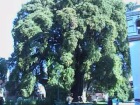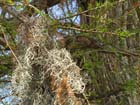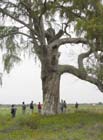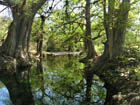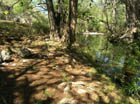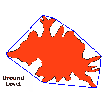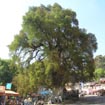Conservation Status

Taxodium mucronatum
Tenore 1853
Common names
Ahuehuete, ciprés, pénjamu, sabino (Spanish) (Dorado et al. 1996), Montezuma cypress, Mexican cypress (Little 1980). "Ahuehuete" is a Nahuatl phrase that means "old man of the water," a fit name for a tree that is always associated with swamps, streams or springs (Bautista 2005). The tree is sometimes also called Ciprés de los Panatanos (Cypress of the Marshes). Additional names in various indigenous languages are presented by Bautista (2005).
Taxonomic notes
Synonymy:
- Taxodium distichum Kunth 1817 non Rich. 1810;
- Taxodium huegelii C. Lawson 1851;
- Taxodium mexicanum Carr. 1855;
- Taxodium distichum (L.) Rich. var. mexicanum (Carr.) Gordon 1858;
- Cuprespinnata mexicana (Carr.) J. Nelson 1866; and
- Taxodium distichum (L.) Rich. var. mucronatum (Ten.) A. Henry 1906.
The 1851 publication of T. huegelii by C. Lawson was overlooked for more than 150 years, during which time the name T. mucronatum was used almost exclusively for this taxon; González-Elizondo and González-Elizondo (2022) have proposed formally rejecting the former name, arguing primarily that Lawson's vague description, unaccompanied by any type specimen, may not in fact apply to this taxon. Pending resolution of this point, most authorities continue to call the ahueheute Taxodium mucronatum, although there is also widespread support for the name T. distichum var. mexicanum due to molecular studies showing an extremely close similarity between all taxa of Taxodium (as discussed in the Taxonomic notes for Taxodium).
The type locality of this species is at the Parque Nacional El Contador, better known as the fabled Gardens of Montezuma. They are just five kilometers north of Texcoco, about 25 km east of the Mexico City airport. This was once (500 years ago) a 400 x 800 meter rectangular park all planted with Montezuma baldcypress at Montezuma's behest. When I visited the site in 2005, nothing remained of the gardens but one big, damaged, barely living Taxodium and a large number of grubbed-out, mostly burnt stumps in an area representing less than a tenth of the former gardens.
Description
As for the genus and Taxodium distichum. The chief differences between this species and T. distichum are (1) disjunct ranges; (2) slightly smaller and less variably-sized female cones in T. mucronatum; (3) "knees" are rare in T. mucronatum; (4) stomata are about equally distributed on both leaf faces in T. mucronatum, but are unequally distributed in T. distichum; and (5) T. mucronatum is not at all frost-hardy (Farjon 2005). Most of these difference could reflect ecological setting rather than relatively invariant character states. You will sometimes read that only T. distichum is deciduous, but in fact both species are annually cladoptosic; T. distichum tends to drop its foliage in the fall or winter, while T. mucronatum does so in the dry season. In parts of Mexico, those seasons coincide. See García Esteban et al. (2004) for a detailed characterization of the wood anatomy.
Distribution and Ecology
Guatemala; Mexico: Chiapas, Coahuila, Distrito Federal, Durango, Guanajuato, Guerrero, Hidalgo, Jalisco, México, Michoacán, Morelos, Nayarit, Nuevo León, Oaxaca, Puebla, Querétaro, San Luis Potosí, Sinaloa, Sonora, Tabasco, Tamaulipas, Tlaxcala, Veracruz, Zacatecas; USA: S Texas, along the Rio Grande valley (Farjon 2005). See also Thompson et al. (1999). It occurs in three often disjunct ecological settings: riparian areas, marshes, and springs. By far the most common of these is riparian areas, where the species can be found growing throughout its native range. It is often a major component of such riparian forests, occasionally forming pure stands, or growing with Platanus, Populus, Salix, Ficus, Inga, or various other taxa through its extensive range. The species commonly grows in canyons in arid regions where surface water does not flow through the year, but where its root system can secure perennial water (Farjon 2005).
Distribution data from USGS (1999). Points plotted as tree icons represent isolated or approximate locations.
Zone 9 (cold hardiness limit between -6.6°C and -1.1°C) (Bannister and Neuner 2001).
Remarkable Specimens
Big and Tall Trees
We visited Chapultepec Park in Mexico City with a laser in February of 2005, and measured many of the tallest trees there; the tallest was 37.8 m tall, which constitutes the tallest known reliably measured specimen that I know of. The Big Tree of Tule in Santa María del Tule, Oaxaca, Mexico, has a girth of 36.2 m and a height of 35.4 m, with a 43.9 m wide crown (Robert Van Pelt e-mail, 2005.11.01). It has for long been thought that the Tule tree might actually represent the fused trunks of several different individuals. However, study of DNA samples from the tree using random amplified polymorphic DNA indicates that it is in fact a single individual (Dorado et al. 1996).
The Tule tree is often cited as having the largest trunk circumference in the world. It is a bit deceptive to claim that the Tule tree has such a large trunk circumference because the tree has a highly buttressed base - if you stretch a tape around it, the tape runs free of the tree in most areas, and the trunk is twice as wide on its primary axis as on the secondary. The drawing (#2 below) illustrates this. The usual method of calculating diameter, dividing girth by π, indicates that the Tule tree has a diameter of 1162 cm. However, calculation of nominal diameter, defined as the cross-sectional wood area expressed as a circle, gives this tree a dbh of 938 cm—a much smaller number, but a more accurate representation of the tree's size. A calculation of the basal area of the tree, and its cross-sectional area at various heights above the base, gives a clearer idea of how immense the tree really is—up to a height of 5 m, where the major branches diverge, it is comparable to the largest specimens of Sequoiadendron.
- El Arból del Tule.
- Footprint of the Tule tree [measured and drawn by Robert Van Pelt in 2005]. The blue line shows the girth as measured by a tape.
- The big tree at Chalma, in the mountains out of Cuernavaca. The tree is in a fenced enclosure. A large spring (volume several hundred litres per second) bursts forth at the base of the tree, and mass baptisms are held at the site nearly every Sunday [C.J. Earle, 2005.02.11].
- The big tree near San Miguel Allende, locally called "La Huerta." The tree appeared to be in the midst of dropping all its foliage, i.e. it was winter-deciduous. A large spring at the tree's base is the water source for the village below [C.J. Earle, 2005.02.18].
- The tree in Zimapan, Hidalgo [Nick Macer, 2006].
There are quite a few other extraordinarily large Taxodium in Mexico, some of which are pictured here. The Tule tree itself grows in a neighborhood that also holds six or seven other very large trees—one tends not to notice them, though, because most are behind walls and not publicly accessible, and because despite their large size (over 300 cm in diameter) they pale into insignificance beside the Tule tree itself. The stand at Santa María del Tule is remarkable because it grows in a former marsh. Interestingly, the oldest known T. mucronatum (described below) also occur in a marsh, although the species is almost always affiliated with riparian areas rather than wetlands throughout its range. We saw extraordinarily large trees at four widely disjunct locations, and of those four, one was growing in a former marsh, and each of the other three had a large spring emerging from the ground within 30 meters of the tree—in one case (the Chalma tree, #3 above) the spring emerges from the roots of the tree itself. Clearly, extraordinary size in this species is associated with a copious and completely reliable water supply.
Among the other large trees we saw, the tree at Chalma was 31.4 m tall with a girth of 18.2 m (558 cm dbh); La Huerta (#4 above) was 22.6 m tall with a girth of 13.3 m (423 cm dbh) and a crown diameter of 37.8 m; and the largest tree at San Pablo Jilotepec (not pictured) was 23.8 m tall with a girth of 14.8 m (471 cm dbh) (Robert Van Pelt e-mail 2005.11.01). It seems that there are likely quite a few trees more than 4 m in diameter. For example, Zimpapan tree (#5 above), grows in a small park in Zimapan, Hidalgo. It has a girth of exactly 50 feet, which corresponds to a DBH of 485 cm (e-mails, Nick Macer, 2006.03.11 and 2006.12.04).
People like to speculate on the age of these giant trees. None of them appear to have been dated using any scientifically credible technique. It is my suspicion that the Tule tree is very old, because it has no large primary branches. If you study the photographs you will find that its major branches are all flange-shaped, with the primary axis of elongation often ten times longer than the secondary axis. Many major branches also show fusions, where different branches have grown together. These features are also seen in very old (i.e., more than 1,000 years) Sequoia and Sequoiadendron. In contrast, the other giant Taxodium that we saw retained some primary branches, the branches were generally circular or mildly elliptical in cross-section, and branch fusions were not observed.
Finally, we observed that these giant Taxodium are not really trees because they do not have trunks. In every case they have extremely large root systems and comparably large live crowns, with essentially no trunk. They could be described as the world's largest shrubs. This is probably a consequence of their open-grown habit. In places where they grow in a stand that has appreciable crown closure, such as in a forest or along a stream, the trees can grow relatively tall with well defined trunks.
The "champion" tree designated by American Forests (2000) in the United States grows in San Benito, Texas. It is rather petite in comparison with the Mexican giants: 216 cm dbh and 25.9 m tall.
Old Trees
"The oldest known trees in Mexico are found in a remarkable wetland in the rain shadow of the Sierra Madre Oriental near Rio Verde, San Luis Potosí. These exceptional Montezuma baldcypress (Taxodium mucronatum) include trees over 1000 years old that are widely spaced along the springs and stream channels that emerge from a mesquite grassland. Montezuma baldcypress is the national tree of Mexico, and the largest individuals at Los Peroles are some 22 meters tall and 2 meters in diameter. Dendrochronological analyses of core samples indicate that the living baldcypress at this site range in age from 200 to over 1140 years old" (Stahle et al. 2004). The oldest specimen yet to be sampled and its age confirmed by crossdating, 1140 years old, is pictured at right.
The Chapultepec Park trees are said to include some of the oldest cultivated trees in the New World (ca. 600 years) (Little 1980), but when I visited the area in 2005 the only evidence I found for this statement was the record that trees such as the "Tree of the Sad Night" had formerly been living in the area. However, this species is the national tree of Mexico and has been widely planted and revered for centuries (much like Ginkgo biloba in the far East or Taxus baccata in England), and it seems reasonably certain that several planted specimens more than 500 years old exist.
Ethnobotany
This tree has one of the most remarkable uses recorded in the conifer literature: the Mexica or Aztec people, and perhaps others within its range, would plant it in palisades within shallow lakes such as the formerly extensive Lake Texcoco, and would fill the space between with earth. In this way, they used Taxodium to turn lakes into farmlands. The great city of the Mexica,Tenochtitlan, was in this way reclaimed from the waters of Texcoco (the story is recounted in interpretive displays at the National Museum of Anthropology in Mexico City).
The Chalma tree, pictured in the gallery above, is described as a "sacred tree" by Bautista (2005). The tree is said to be 2270 years old. Pilgrims to Chalma initiate their religious rites in the shade of this giant tree. It is the custom to dance at this tree, and many travelers wear a crown of flowers when they visit. Bautista (2005) also reports that the tree's bark is used as a diuretic, its leaves were used to cure scabies and to adorn altars, and its resin was used to treat ulcers, skin diseases, and toothache.
Observations
As noted above, the species can be seen in Chapultepec Park in Mexico City, and the largest specimen can be found at Santa Maria del Tule, about 7 km east of the Oaxaca City center. Generally, it is a reasonably common tree in riparian areas throughout its range, and it is also a fairly common ornamental within its range (indeed, most of the largest known trees were probably planted originally, since the tree has been revered in Mexico since preColumbian times).
Remarks
The 1960 Preston Sturges film "The Magnificent Seven" features some fine photography in a stand of T. mucronatum in Durango. This stand hosts the main campsite of the Seven and is featured in many scenes.
See the riparian forest photos at right; these are my field notes: The bottom three photos are along the stream from Jalpan to Rio Verde, which is for the most part lined with Taxodium. They are predominantly large mature trees. The roots completely make up the banks of the stream and form a well-defined steep bank that drops off into relatively deep water (low channel width/depth ratio). The roots bind the rocks and soil together to retard erosion of the floodplain during peak flows, and thereby help to stabilize the stream channel. The trees bear a pretty heavy epiphyte load, virtually all bromeliads, some of them pretty big. I'd guess they weigh 3 or 4 kg plus the accumulated litter. That's not a real heavy loading, but a good sized tree might have a couple tonnes dry weight of epiphytes. Seedlings are not common but I did find several that still bore their cotyledons. Haven't seen any root sprouts, I don't know if they do that. The larger and older trees bear fire scars. I assume, given the fabulous water supply, that none of these trees are very old and they're all growing like topsy. I wish I could see this stand early or late in the day, when the light is better for photography. As it is, my photos can't do it justice.
Citations
American Forests 2000. The National Register of Big Trees 2000. Washington, DC: American Forests.
Bautista, Alicia Elena Martínez. 2005. El Ahuehuete. http://www.semarnat.gob.mx/comunicacionsocial/nov01tex01.shtml, accessed 2005.11.01, now defunct.
Dorado, Oscar et al. 1996. The arbol del Tule (Taxodium mucronatum Ten.) is a single genetic individual. Madroño 43(4):445-452. Available: Biodiversity Heritage Library, accessed 2021.12.18.
Stahle, David W., Jose Villanueva Diaz, Eladio Cornejo Oviedo, and Matthew D. Therrell. 2004. The Ancient Montezuma Baldcypress at Los Peroles, San Luis Potosi, Mexico. Unpublished manuscript.
Tenore, M. 1853. Index seminum quae anno 1853 in Horto Regio Neapolitano offenruntur. Ann. Sci. Nat. Bot., sér. 3, 19:355-356.
See also
Farjon (2005).
Hall et al. 1990. Genetic uniformity of El Arbol del Tule (The Tule Tree). Madroño 37:1-5.
